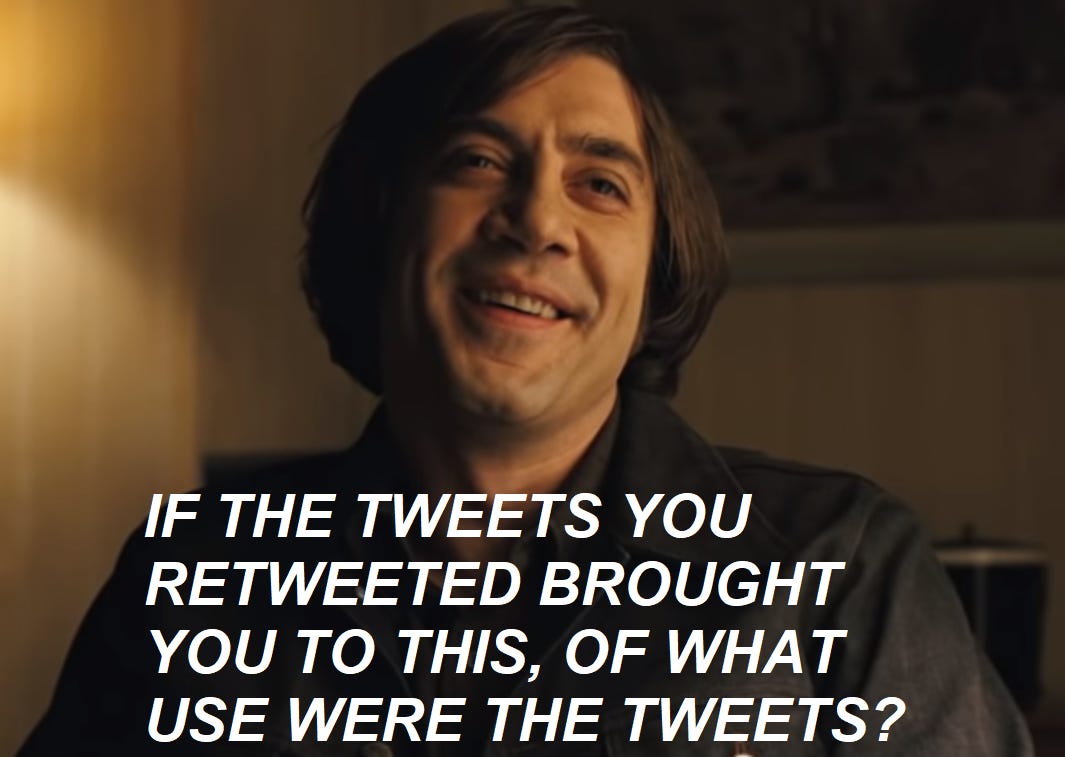Toward A Grand Unified Theory Of Social-Media Sociopathy
When the brakes are completely melted and everyone's freaking out

It’s so goddamn cold.
Admin Stuff
You know how to filter these emails if you want to, right? Obviously I want as many people as possible to open and read these newsletters — that’s kind of the point. But I also recognize that a busy inbox can be anxiety-provoking, and I’m on a couple listservs that would absolutely destroy my own inbox if I hadn’t set things up so that GMail filters their messages directly into folders where I can read them when I have time. For anyone who doesn’t know how to create such a filter but who might want to, here are instructions for doing so in Gmail, Hotmail, Outlook, and Yahoo. The from: address to be filtered is jessesingal@substack.com.
I’ll be slowing down the pace a bit. If I get to it, I plan on including, in tomorrow’s newsletter, some information about my long-term plans for Singal-Minded. For the sake of my own sanity and ability to get other projects done, part of that plan includes dialing back my output to about three newsletters per week or so starting next week (this initial period of doing [frankly] too many seems to have worked, subscription-growth-wise, and I think it was the right decision). But nothing’s set in stone and I’m reserving the right to experiment a bit. This newsletter, after all, is but a tiny mewling babe, its brain mushy and as-yet-unformed.
Here’s a Great Tweet
There are so many bad tweets, but sometimes a tweet is great. When a tweet is great, I will highlight it in a sporadic feature called “Here’s a Great Tweet.”
Today’s inaugural Great Tweet was sparked by genuine bastard Joe Arpaio’s claim that Robert Mueller went overboard with his “dramatic predawn raid” on Roger Stone’s house. Whether or not that view has merit, Radley Balko of the Washington Post argued that maybe Arpaio wasn’t the ideal messenger:

That’s a great tweet! (And yes, the Seagal incident really happened.)
MUSIC BREAK: Amusement Parks on Fire - Venus in Cancer
One of the nice things about working in media is there’s tons of free, well, media: books, music, and so on. Everyone’s trying to send you stuff in the hopes you’ll cover it, and at every newspaper and magazine in the country — or the seven that still exist, at least — certain corners of the office are piled high with freebies. One day in 2010 or so, when I was a humble contractor for The Boston Globe’s editorial pages, I walked by a cabinet with some free CDs on it and saw one with a very evocative cover:

I grabbed it on a whim, and now Amusement Parks on Fire, out of Nottingham in the U.K., is one of my top 20 or so favorite bands. I’m terrible at describing music but there’s some shoegaze and post-rock and other stuff going on here — it just works. At its best, APoF makes you feel like you’re barreling through space in a juggernaut of a starship just wantonly shooting lasers like pew pew pew, pew pew pew and yes I’m in my mid-30s what of it? (This song’s from a different album but it’s one of their true bangers.)
Let’s Take This Opportunity to Better Understand Why Twitter Turns People Into Grotesque Hulking Demon-Creatures
A tweetstorm by Brian Earp, a philosopher and psychology researcher who has written some really good stuff like this, caught my eye, and he gave me permission to compile it into a few paragraphs and publish it here (I’m making minor style tweaks):
I have a hypothesis about what might contribute to *moral outrage* being such a big thing on social media. Imagine I’m sitting in a room of 30 people and I make a dramatic statement about how outraged I am about X. And, say, five people cheer in response (analogous to liking or retweeting). But suppose the other 25 people kind of stare at the table, or give me a weird look or roll their eyes, or in some other way (relatively) passively express that they think I’m kind of overdoing it or maybe not being as nuanced or charitable or whatever as I should be.
In real life we get this kind of “passive negative” feedback when we act morally outraged about certain things, at least sometimes. Now, a few people in the room might clear their throat and actively say, “Hey, maybe it’s more complicated than that,” and on Twitter there is a mechanism for that: replies. But it’s pretty costly to leave a reply pushing back against someone’s seemingly excessive or inadequately grounded moral outrage, and so most people probably just read the tweet and silently move on with their day. And there is no icon on Twitter that registers passive disapproval.
So it seems like we’re missing one of the major in-real-life pieces of social information that perhaps our outrage needs to be in some way tempered, or not everyone is on board, or maybe we should consider a different perspective. If Twitter collected data of people who read or clicked on a tweet, but did NOT like it or retweet it (nor go so far as write a contrary reply), and converted this into an emoji of a neutral (or some kind of mildly disapproving?) face, this might majorly tamp down on viral moral outrage that is fueled by likes and retweets from a small subset of the “people in the room”... Thoughts?
Part of the reason Earp’s tweetstorm jumped out at me is I’ve been thinking a lot about brakes lately. Humans can be mean and cruel to one another in all too many situations, but our real-life social communities tend to have at least some mechanisms in place to slow down our worst social tendencies. Think of all the cultures in which bearing false witness is a serious offense: That’s a braking mechanism that can sometimes slow rumors down before they accelerate out of control and do potentially grievous harm.
Plus, as Earp notes, we’ve evolved some natural social/psychological brakes in the form of feedback we give to and receive from others. If you put 10 people in a room where they have to interact face-to-face and have them chat for an hour, it’s unlikely you’ll generate the outrage raging every second of every day on Twitter — even if they have some real disagreements on hot-button issues. Many subtle social influences militate against this sort of outcome (though of course sometimes they’re swamped by other social influences that promote conflict).
But when there are no brakes, boy do things go haywire (please do not spread outrage over my mixing of metaphors). That’s part of the reason I’m fascinated by dysfunctional internet communities — what they tend to have in common, regardless of their ideological orientation, is that the brakes have worn down or have melted off entirely. A couple nights ago I tweeted about a gonzo pileon going on in the deeply dysfunctional young-adult-fiction Twitter community, and yesterday the bullies behind it won: The first-time author who was targeted by this almost entirely unfair, misleading campaign announced she is not going to publish her book. (I’m working on a story about this and will of course link to it the next newsletter I publish after it goes up.)
One of the reasons this pileon gained momentum over the last week, and that so many overheated YA Twitter outrage campaigns have in the past, is that this community lacks brakes. Or, in Earp’s version: It lacks the internet equivalent of social cues indicating that you’ve lost the room a bit. I have accumulated an unfortunate amount of knowledge about questionable internet pileons at this point, and one thing that is almost always true is that if the tweets about someone are 80% negative, the emails are a different story entirely — much more positive. There are always, always a lot of people scared to speak up against outrage either because a certain pluralistic ignorance takes hold — everyone thinks that everyone else in their community is cool with what’s going on — or because whatever the actual full numerical breakdown of those in favor of versus opposed to a given outrage train, it’s loudly broadcast that there’s a sizable cohort of people ready and willing to jump all over anyone who attempts to slow it down. (There’s a fascinating anti-bullying intervention developed in part by the MacArthur-Grant-winning psychologist Betsy Levy Paluck that acknowledges and targets pluralistic ignorance in a really clever way. It’s one of my favorite studies I’ve ever written about.)
I’m fascinated by Earp’s idea of some sort of indicator of the number of people not engaging with a tweet. Would it slow down the train if it turned out that a viral outrage tweet was, in fact, only being retweeted or liked by .001% of the people who viewed it, and a slightly frowning face indicated as such? I’m a bit pessimistic that it would — people respond to outrage so automatically, and with such an eye toward ingroup incentives and rewards, that I’m not sure information of this form would really deter them. That is: It can be true that you’re one of the 0.001% of people who spread an outrage tweet, but that doing so helps solidify your status in the community, brings you favor from its other influential members, and so on. (I also worry about potential situations in which people get punished for being genuinely courageous — what if someone makes a really good, controversial point on Twitter, and the tweet gets slapped with a frowny face because only 0.0000001% of other users have the guts to help amplify it? It’s still a good and worthwhile tweet!)
I could definitely be wrong about this, though. Either way, this is a good question for you guys: What are some other worthwhile ideas for online brakes, or online equivalents of skeptical real-world faces, or whatever else you wanna call it? How do we help people understand that social media often stokes our worst tendencies and causes us to act in ways we never would in real life?
Questions? Comments? Outrage campaigns? Unfounded accusations? I’m at singalminded@gmail.com, or on Twitter at @jessesingal.

